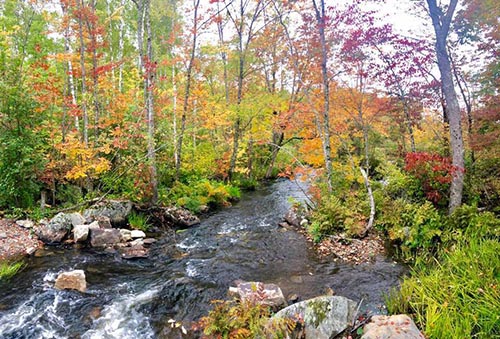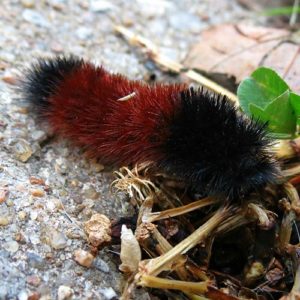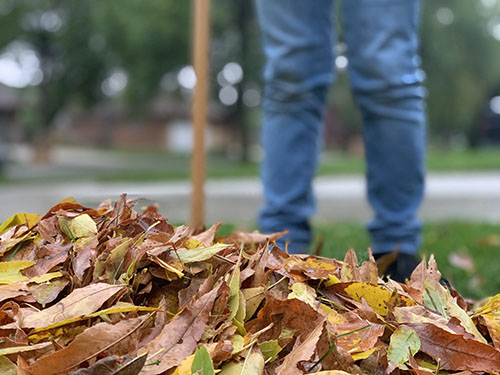Think of fall in the eastern U.S. and fall foliage is likely to be high on the list of things that comes to mind. People will drive for hundreds of miles to admire a forest ablaze in bright red, orange, and yellow leaves. More than one vacation, wedding, or other special event is planned each year with the hopes of hitting peak fall color in an area. Kids love tromping through the fallen leaves and making them crunch as loud as they can. And I’ve yet to meet anyone who enters the woods during the fall and proclaims how ugly the woods look with so many leaves on the ground.

But when it comes to our yards, the expectations often change. Society promotes the idea that we need to remove every leaf from our yards. In many cities and towns, you are encouraged to pile your fall leaves up near the street or bag and place them near the street so they can be picked up or disposed of. In rural areas, it is common to rake of blow fall leaves into a ditch and burn them. Yet, if we want to make our yards more pollinator and wildlife-friendly, then the better choice is to leave your fall leaves.
Why should you leave your fall leaves?
Fall leaves are essential overwintering habitat for many different types of pollinators and wildlife. Providing overwintering habitat, in addition to summer habitat, helps ensure that you are taking care of pollinators and wildlife throughout the entire year.
Caterpillars, such as woolly worms or woolly bears, will spend the winter snuggled under the leaves in the insect form of hibernation. Several other species of butterflies also spend the winter as caterpillars buried under leaves. Many other species of butterflies and moths will overwinter in the leaves either as a cocoon (moth) or chrysalis (butterfly). Bumble bee queens may also overwinter in piles of leaves.
In addition to the pollinators, salamanders and other small wildlife will search out leaves for overwintering cover. Songbirds, such as Carolina wrens and eastern towhees, will pick through the leaves hunting for prey. There are also indirect benefits of leaving your fall leaves. As the leaves break down, they provide natural fertilizer for the plants around them. Plus, not raking and disposing of your fall leaves saves you time to do other fun things.

(I sometimes hear that if you don’t rake your leaves then they will kill your grass. All I can say is that I’ve purposely killed part of the grass in the yard of every house that we’ve owned. Killing that grass was never as easy as just letting my fall leaves stay on the grass. As a family who hates to mow, my husband and I both really wish it was that easy.)
It doesn’t have to be all or nothing
Fall leaves are valuable overwintering habitat for many different animals, but I also don’t want people to feel guilty if they can’t leave all of their fall leaves. I know people trying so hard to “do the right thing” that they felt like they had to ask me if it was ok to blow or sweep the leaves off their driveway or similar high-traffic locations. They almost felt guilty for considering it, even though the reason why they wanted to remove those leaves came down to safety issues. We don’t want to take it to that extreme.
First of all, is it really a good idea to provide habitat in an area where you will be repeatedly driving or walking? What’s going to happen to any critters that may decide to overwinter there? Second, we are talking about the areas surrounding our homes, which means we live there too. Thus, our personal health and safety need to be considered as well. Wet leaves on a hard surface can be slick, especially for people who might have less mobility or agility. Cars and motorcycles can also have issues with wet leaves, especially on a hill or going around a curve. It’s ok to find a balance between our human needs and those of the critters we invite into our yards. It doesn’t have to be all or nothing.
Finding your balance
If leaving all of your fall leaves in place isn’t a good option for you, then feel free to get creative in coming up with solutions that work for you and your family. Maybe you have a really small front yard and if you don’t rake your leaves then they are constantly blowing onto the community sidewalk or street. Can you move the leaves to your backyard or side yard? Maybe you have a larger front yard, but neighborhood standards view yards filled with unraked leaves as “unkempt.” Could you rake and maintain a winding path through the leaves that would invoke the feeling of a path through the woods, while also giving the “cues to care” that show this is a design choice, not a lack of caring or laziness? Those are just a couple of possible solutions for some common challenges that I hear about. There are lots of others. In the end, you have to find the right balance for you and your family. Just do the best you can, and sometimes that means getting creative with your solutions.


Backyard Ecology: Exploring Nature in Your Backyard
Nature isn’t just “out there.” It’s all around us, including right outside our doors. Hi, my name is Shannon Trimboli, and I am the host of Backyard Ecology. I live in southcentral Kentucky and am a wildlife biologist, educator, author, beekeeper, and owner of a nursery specializing in plants for pollinators and wildlife conservation. I invite you to join me as we ignite our curiosity and natural wonder, explore our yards and communities, and improve our local pollinator and wildlife habitat. Learn more or subscribe to my email list at www.backyardecology.net.

Leave a Reply